
Air Canada Flight 143, commonly known as the Gimli Glider, was a Canadian scheduled domestic passenger flight between Montreal and Edmonton that ran out of fuel on Saturday, July 23, 1983, at an altitude of 41,000 feet (12,500 m), midway through the flight. The flight crew successfully glided the Boeing 767 to an emergency landing at a former Royal Canadian Air Force base in Gimli, Manitoba, which had been converted to a racetrack, Gimli Motorsports Park. It resulted in no serious injuries to passengers or persons on the ground, and only minor damage to the aircraft. The aircraft was repaired and remained in service until its retirement in 2008. This unusual aviation incident earned the aircraft the nickname "Gimli Glider."

Montréal–Trudeau International Airport or Montréal–Trudeau, formerly known and still commonly referred to as Montréal–Dorval International Airport, is an international airport in Dorval, Quebec, Canada. It is the only Transport Canada designated international airport serving Montreal and is situated 20 km (12 mi) west of Downtown Montreal. The airport terminals are located entirely in the suburb of Dorval, while one runway is located in the Montreal borough of Saint-Laurent. Air Canada, the country's flag carrier, also has its corporate headquarters complex on the Saint-Laurent side of the airport. It also serves Greater Montreal and adjacent regions in Quebec and eastern Ontario, as well as the states of Vermont and northern New York in the United States. The airport is named in honour of Pierre Elliott Trudeau, the 15th Prime Minister of Canada and father of current Prime Minister Justin Trudeau.

Montréal–Mirabel International Airport, originally called Montréal International Airport, widely known as Mirabel and branded as YMX International Aerocity of Mirabel, is a cargo and former international passenger airport in Mirabel, Quebec, Canada, 21 nautical miles northwest of Montreal. It opened on October 4, 1975, and the last commercial passenger flight took off on October 31, 2004.

Swissair Flight 306, a Sud Aviation SE-210 Caravelle III, named Schaffhausen, was a scheduled international flight from Zürich to Rome, via Geneva. It crashed near Dürrenäsch, Aargau, on 4 September 1963, shortly after take-off, killing all 80 people on board.
Air Cargo Carriers is a cargo airline based in Milwaukee, Wisconsin, United States. ACC was established in 1986 and operates contract feeder cargo services for UPS, FedEx and DHL, additionally providing on demand charter service. Air Cargo Carriers, Inc. is the largest civilian operator of Short aircraft in the world. Its main base of operations is Milwaukee Mitchell International Airport, in Milwaukee.

The Learjet 25 is an American ten-seat, twin-engine, high-speed business jet aircraft manufactured by Learjet. It is a stretched version of the Learjet 24.
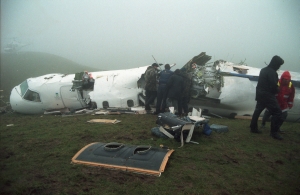
Ansett New Zealand Flight 703 was a scheduled flight from Auckland to Palmerston North. On 9 June 1995, the de Havilland Canada Dash 8-100 aircraft crashed into the Tararua Range on approach to Palmerston North. The flight attendant and three passengers died as a result of the crash; the two pilots and 15 passengers survived.
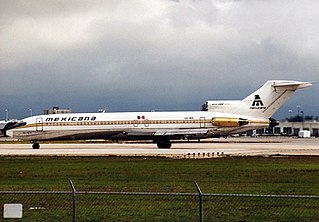
Mexicana de Aviación Flight 940, operated by Mexicana de Aviación, was a scheduled international flight from Mexico City to Los Angeles with stopovers in Puerto Vallarta and Mazatlán on March 31, 1986, utilizing a Boeing 727-200 registered as XA-MEM, when the plane crashed into El Carbón, a mountain in the Sierra Madre Occidental mountain range northwest of Mexico City, killing everyone on board. With 167 deaths, the crash of Flight 940 is the deadliest aviation disaster ever to occur on Mexican soil, and the deadliest involving a Boeing 727.

Nolisair was a Canadian company, the parent company of Nationair Canada, a Canadian airline, and of Technair, an aircraft maintenance company. The company was owned by Robert Obadia. The headquarters was located in the Nationair Canada Building on the property of Montréal-Mirabel International Airport in Mirabel, Quebec.

S7 Airlines Flight 778(S7778/SBI778) was a scheduled domestic passenger flight from Moscow to Irkutsk, Russia. On 9 July 2006, at 06:44 local time, the Airbus A310-324 aircraft operating the route overran the runway during its landing in Irkutsk. The aircraft failed to stop and crashed through the airport's concrete perimeter fence, struck rows of private garages and burst into flames, killing 125 people.
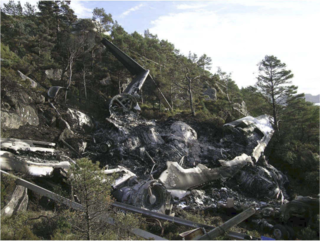
Atlantic Airways Flight 670 was a crash following a runway overrun of a British Aerospace 146-200A at 07:32 on 10 October 2006 at Stord Airport, Sørstokken, Norway. The aircraft's spoilers failed to deploy, causing inefficient braking. The Atlantic Airways aircraft fell down the steep cliff at the end of the runway at slow speed and burst into flames, killing four of sixteen people on board.

Penghu Airport, formerly Magong Airport, is a domestic airport in Huxi, Penghu County, Taiwan. Handling 2,380,265 passengers in 2017, it is the fifth-busiest airport in Taiwan. The ROC Air Force's Magong Air Base is also located here.

On 26 May 2008, Moskovia Airlines Flight 9675, a Moskovia Airlines An-12 cargo aircraft crashed near Chelyabinsk, Russia. After taking off for a flight to Perm, it turned back due to a fire on board and crashed 11 kilometres from the airport, killing all nine crew members.

Spanair Flight 5022 was a scheduled domestic passenger flight from Barcelona–El Prat Airport to Gran Canaria Airport, Spain, with a stopover in Madrid–Barajas Airport that crashed just after take-off from runway 36L at Madrid-Barajas Airport to Gran Canaria Airport at 14:24 CEST (12:24 UTC) on 20 August 2008. The aircraft was a McDonnell Douglas MD-82, registration EC-HFP. Of the 172 passengers and crew on board, 154 died and 18 survived.

Propair Inc. is a charter airline with its headquarters and main base at the Rouyn-Noranda Airport in Rouyn-Noranda, Quebec, Canada. It operates charter and medevac flights and had a secondary base at Montréal–Trudeau International Airport, but it closed in July 2018.
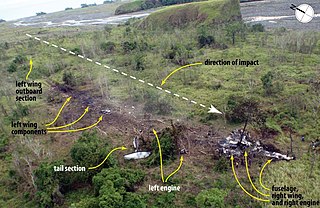
On 13 October 2011, Airlines PNG Flight 1600, a Dash 8 regional aircraft on a domestic flight from Lae to Madang, Papua New Guinea, crash-landed in a forested area near the mouth of the Guabe River, after losing all engine power. Only four of the 32 people on board survived. It was the deadliest plane crash in the history of Papua New Guinea.

Sriwijaya Air Flight 062 (SJ062/SJY062) was a scheduled domestic passenger flight, operated by Indonesian airline Sriwijaya Air from Soekarno-Hatta International Airport, Jakarta to Sultan Thaha Airport, Jambi. On 27 August 2008, the aircraft operating the flight, a Boeing 737 series 200 registered as PK-CJG, overran the runway and crashed onto a house during its landing attempt at Jambi. Due to the accident, 26 people were injured, including 3 people on the ground. One person later succumbed to his injuries. Everyone on board the aircraft survived the crash. It was the first fatal crash in Sriwijaya Air's operational history and was the only fatal accident until Sriwijaya Air Flight 182 crashed in 2021.

East African Airways Flight 720 (EC720) was an international scheduled passenger flight, operated by jointly operated East African Airways, routing from Kenya via Ethiopia and Italy to the United Kingdom with a Vickers VC10. On 18 April 1972, the aircraft burst into flames and crashed while taking off from Addis Ababa Bole International Airport, killing 43 out of 107 occupants on board. It is the third deadliest aircraft accident on Ethiopian soil.
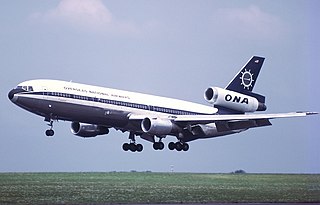
Overseas National Airways (ONA) Flight 032 was a non-scheduled positioning flight operated by Overseas National Airways with a McDonnell Douglas DC-10-30CF. On November 12, 1975, the flight crew initiated a rejected takeoff after accelerating through a large flock of gulls at John F. Kennedy International Airport, resulting in a runway excursion. Of the 139 aircraft occupants, all survived, while the aircraft was destroyed by an intense post-crash fire. The National Transportation Safety Board concluded that the probable cause of the accident was bird ingestion into the right-hand engine, causing an uncontained engine failure that ruptured several landing gear tires and disabled the engine's hydraulic system, in turn partially disabling the spoilers and the landing gear brakes. Contributing to the accident was the resultant failure of the affected engine's thrust reverser and the wet runway. The accident aircraft is claimed to be the largest commercial airliner ever destroyed due to a bird strike.

Capitol International Airways Flight C2C3/26 was a chartered McDonnell Douglas DC-8 Military Airlift Command (MAC) contract flight operated by Capitol Air from McChord Field in Tacoma to Cam Ranh Bay in Southern Vietnam via stopovers at Anchorage and at Yokota Air Base in Japan. The aircraft crashed after a botched take-off attempt from Runway 6R at Ted Stevens Anchorage International Airport on November 27, 1970. Of the 229 persons aboard the jet, 47 perished due to the post-crash fire with 49 persons injured.



















